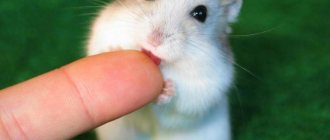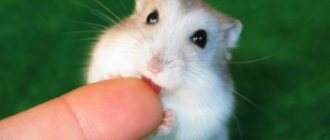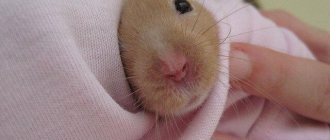03/05/2021 16,191 Hamsters
Author: Olga
Cute, charming fluffy balls - hamsters are quickly winning our hearts. And the one who got such a pet is in vain to think that there will be little trouble with it, because it does not need to be walked or trained. Hamsters also need proper care, because various parasites prey on these animals. Therefore, in order to understand why a hamster itches and what to do in this case, we suggest studying all the possible causes of this unpleasant condition.
[Hide]
Stress
Hamsters are susceptible to stress. If your hamster itches and your pet's skin and fur look healthy, scratching is a sign of psychological discomfort. When a hamster rubs its back against cage bars and other objects, it marks its territory with its scent. If it seems to you that the dwarf itches often, watch it. A couple of times an hour is not a pathology, but a natural behavior of the animal.
Possible causes of stress:
- moving to a new place;
- proximity to other animals, including relatives;
- frequent change of bedding and washing of the cage, new items in the home;
- disturbance of daytime sleep, loud sounds (TV).
If the pet has recently moved into the house, it should be given a couple of weeks to adapt. You cannot put your hands into the cage while the animal is inside. It is not recommended to take it out of the cage with your hand. Contact between a cautious rodent and its owner should be voluntary.
Knowing why hamsters itch in nature, it is easier to distinguish between pathological itching and the instinctive behavior of a healthy animal. The scent glands of Syrian hamsters are located on the sides, while in dwarf hamsters they are located on the stomach. If a Djungarian hamster scratches its belly on the floor of the cage, it is marking its territory.
Ectoparasitic diseases
Demodicosis is very common among hamsters, the causative agent of which is the Demodex Aurati mite living deep inside the hair follicles. The size of the parasite does not exceed 3 mm, but causes a lot of inconvenience to the animal. Due to the conditioning of the disease by the influence of the external environment, for the development of the clinical picture, in addition to the mites themselves, accompanying signs are necessary - a lack of vitamin C or poor care. Demodicosis does not cause severe itching, but manifests itself in the form of dandruff and scabs - small crusts covering the surface of the wound. You can cure your pet with the drugs “Metriphonate” or “Cytiate”.
The reason why the Djungarian hamster (as well as any other breed of hamster) itches may be a dangerous disease transmitted by another type of mite called “Notoedres cati”. The ears, muzzle, paws and skin around the anus are mainly affected, on which a dry crust of gray shades and dandruff form. Sick animals lose their fur and suffer from severe itching; the skin is damaged by scratching and provokes the development of infections. In most cases, hamsters die as severe exhaustion progresses against the background of the disease. You can try to cure the animal with the drug Hexachloran.
It is extremely rare that the simplest of ectoparasites – lice and lice eaters – are found in hamsters. Insects do not cause much harm, causing only severe itching, and with it discomfort and nervousness due to constant bites. You can fight them with contact types of poisons like Bromocyclen. To destroy parasites, the hamster should be bathed in a 5% solution of this drug, repeating the procedure 2 times at weekly intervals. Triple treatment is necessary to prevent the development of larvae that the fleas have already laid. During treatment, the animal’s cell must also be treated with the same drug. You can also treat your hamster's home with Metrifonat. Please note that a pet can become infected with cat or dog fleas if all pets live in the same room. There is no need to worry too much, since “foreign” fleas do not stay in the hamster’s fur for a long time.
Allergy
Allergies can be food or contact. A food problem occurs when improper feeding occurs, when the hamster receives food “from the table” - sweet food, nuts, strawberries and other exotic delicacies. Contact – for household chemicals, filler (coniferous sawdust). If the animal sits in the owner's arms, it may be allergic to perfume.
When allergies occur, not only the animal’s skin is affected - the ears turn red, transparent discharge appears from the eyes and nose, and the animal may sneeze.
Treatment does not require the use of antihistamines; it is enough to identify and remove the cause. The bedding is replaced with white paper napkins, and all excesses are removed from the diet.
Avitaminosis
The lack of ascorbic acid is especially aggravated during diseases of an infectious or parasitic nature, and sometimes accompanies them. Vitamin deficiency has a detrimental effect on the pet, as the immune system becomes weakened, opening the way to various diseases. Hamsters constantly catch colds and more often suffer severe infections. In acute cases, a lack of vitamin B manifests itself in the form of weakness, the development of anemia and bleeding gums, which become very swollen and painful when touched. If timely treatment is not started, the animal may lose all its teeth. The kidneys also suffer and the joints swell.
To prevent vitamin deficiency, a hamster's diet should always contain a special food with a high content of ascorbic acid. In severe cases, you should not self-medicate your pet. He will need the help of a veterinarian, who will determine his daily dose of vitamin C and prescribe a course of treatment.
Scabies (mites)
The most common cause of itching in hamsters is infection with various types of parasitic mites: sarcoptic mange, notoedrosis, demodicosis. If left untreated, the disease takes over the entire body. The hamster constantly itches, injuring the skin. The skin is inflamed and hair falls out. Areas of baldness are extensive, the skin has scratches, scabs, and dandruff. If a hamster scratches itself until it bleeds, the wounds become infected and can fester. The disease causes severe suffering to the animal and, without treatment, leads to death due to exhaustion. Eating is disrupted and sleep is impossible.
Most often, demodicosis . A pet does not always become infected from other animals, but may be a carrier of parasites from birth. The asymptomatic, “dormant” form of the disease is activated due to stress or for no apparent reason. Any hamster can get sick because of this, even in “sterile” conditions.
It is not easy to cure scabies in an adult rodent. In the generalized form, the hamster's skin looks like a continuous wound, covered with crusts, and there is no hair. A course of ivermectin injections (Ivomec, Otodectin) is being administered. For small animals, otodectin is more convenient; it is a 0.1% (not 1%) solution of ivermectin. Minimum – 2 injections with an interval of 10 days (dose 0.2 ml per 1 kg), sometimes up to 6 injections. You can carry out external treatments with fipronil (spray for rodents "Bars").
hamster scabies
How can I help my fluffy?
The main thing is to pay attention to the itching animal in time. Of course, it will not be possible to diagnose the disease on your own. The first thing you need to do is isolate the itching hamster. The veterinary clinic must take skin scrapings from your pet, possibly fragments of fur, and use them to determine the presence of a particular parasite. If there are no parasites, the hamster may be suspected of having an allergy.
A veterinarian must prescribe drug treatment for a hamster, because due to its miniature size, the animal needs minimal doses of medication, which is not always possible to calculate independently. Stronghold drops are excellent for killing ticks. To get rid of fungus, bathing in special shampoos and treatment with antifungal ointments are suitable. It is imperative to disinfect the cage to destroy tick and flea eggs or fungal spores.
Diagnostics
Not every veterinarian knows what to do if a hamster itches. It is better to find out in advance whether the clinic has a rodent specialist - a ratologist. If your hamster constantly scratches its skin or just itches a lot, a visit to the clinic cannot be avoided. The doctor will adhere to the following algorithm for making a diagnosis:
- anamnesis collection: analysis of diet and living conditions;
- examination in a dark room with a Wood's lamp. In the blue light of an ultraviolet lamp, some fungi glow green; white areas indicate inflammation of the skin. Wood's lamp can reveal lichen (mycoses), show the general condition of the skin;
- scrapings and culture on a nutrient medium are carried out if lichen is suspected;
- deep skin scraping.
In the affected area and always at the border of a healthy and diseased area of skin, material is taken for microscopy. Crusts, hairs and deep skin scrapings. The procedure often horrifies the owner: the skin is scraped until drops of blood appear. However, this allows you to obtain a lot of information: if mites are visible under a microscope, you can even determine the genus of the parasite.
With sarcoptic mange and demodicosis, it can be difficult to see mites in scrapings - they live so deep in the dermis. Therefore, a negative diagnostic result does not exclude the diagnosis of acariasis.
Parasites in hamsters
Fleas in hamsters, lice or lice are extremely rare. If you notice parasites in your pet's fur, you should immediately bathe it. Animals don't really like water, but in this situation, bathing is a necessity. A bath for a rodent must be prepared in a special way:
- You need to prepare a solution at the rate of 1.5 grams of 5% bromocyclene per 1 liter of water.
- The water should be heated, it should be warm, but in no case hot.
The hamster needs to be immersed in the bath for a few minutes. You need to make sure that water does not get into his eyes, ears and mouth, so that the animal does not choke. After you remove your pet from the bath, you need to dry it with a towel and dry it under the light of a red lamp.
You can also choose various sprays, aerosols and drops to treat parasites. Regardless of how you treat your hamster, after 8 days you need to carry out the treatment procedure again. This will eliminate the possibility of relapse.
You also need to thoroughly disinfect your pet’s home. This can be done using bromocyclene. Immediately after this, the hamster should not be returned to its home; the cage must be completely dry. It is better to release the animal back into its home 2-3 weeks after treatment for parasites.
Treatment
Diet and conditions of detention
Regardless of the diagnosis, careful dietary instruction is provided. All possible allergens are excluded; flaxseed is given for quick healing of the skin.
The cage and accessories are disinfected, the bedding is replaced with paper towels. Solitary confinement and peace are required.
Fighting the cause
For ectoparasites (fleas, lice, lice), ear and regular scabies, ivermectin or other insecticides are prescribed. For lichen - antifungal drugs. It is important to observe the duration and frequency of prescribed treatments.
What not to do: wet and bathe the animal, self-medicate. Even if you are sure that the animal has parasites, it is better to check the dosage of medications with a doctor. Many medications are toxic to tiny rodents such as the Syrian or Djungarian hamster.
Video “Cleaning a hamster cage”
In order to protect your hamster from various parasites and fungi, you need to thoroughly clean his cage. And the video will further tell you how to do it correctly.
Sorry, there are no surveys available at this time.
Was this article helpful?
Thank you for your opinion!
The article was useful. Please share the information with your friends.
Yes (50.00%)
No (50.00%)
X
Please write what is wrong and leave recommendations on the article
Cancel reply
Rate the benefit of this article: Rate the author ( 4 votes, average: 4.75 out of 5)
Discuss the article:
Common diseases that cause itching and scratching in hamsters.
Avitaminosis
The cause of deterioration in the condition of the skin and coat is often an unbalanced diet, leading to vitamin deficiency - vitamin deficiency. Treatment in this case will be to contact a specialist with the question of selecting a complete diet, enriched with all the necessary macro and micro elements.
Allergy
When contacting with aggressive substances, such as household chemicals, flavors, dyes contained in food, there is a risk of allergic dermatitis. For example, when feeding commercial food of questionable quality, you may notice that the Djungarian hamster itches and becomes covered in a rash. The main rule in the treatment of such a disease will be to completely reduce contact with potentially dangerous allergens.
Demodicosis
A dangerous disease manifested by pronounced itching is demodicosis. This disease is the result of a weakened animal’s immune system. Selection of the correct treatment tactics for this skin disease is possible only by a veterinarian.
A general recommendation when diagnosing a hamster with demodicosis is to hygienically clean the pet’s habitat using special disinfectant solutions. In addition, a sick person should be quarantined if there are other animals in the house.
Fleas and Parasites
An unpleasant, but very common cause of damage to the outer covering of hamsters are fleas and lice. It is not difficult to notice them during a visual inspection. If parasites are detected, it is necessary to carry out treatment after consulting a specialist.
In conclusion, it is worth mentioning that only timely diagnosis, as well as close attention to the pet’s condition, will help to immediately notice excessive scratching and determine its causes. Every pet owner tries to surround him with attention and care, but sometimes problems happen
If your hamster itches, you need to find out the cause of this condition and take the necessary measures.
Every pet owner tries to surround him with attention and care, but sometimes problems happen. If your hamster itches, you need to find out the cause of this condition and take the necessary measures.
Lichen
This is a skin disease caused by a viral infection or microscopic fungi. Depending on the pathogen, there are two types of lichen: ringworm and pink lichen.
Rodents with weakened immune systems, mechanical trauma to the skin, and elderly animals are at risk of infection.
The following symptoms are typical for lichen:
- baldness;
- the appearance of inflamed areas;
- itching;
- loss of appetite.
If the disease is confirmed, the sick hamster is isolated from other pets, the cage, bowls, wheel and all objects that came into contact with the infected animal are disinfected. The most effective means for this will be a formaldehyde solution or a sulfur-carbolic mixture.
For treatment, antifungal drugs are used, which are prescribed by a specialist, who will also tell you the dosage and duration of the course. Hair is removed from damaged areas of the body as they are contaminated with fungal spores.
Dried crusts are softened and cut off, the area is treated with salicylic ointment, and the edges are treated with iodine. It is also recommended to support your pet’s body with immunostimulating drugs and probiotics during the treatment period.
Ringworm
A characteristic feature is rounded bald patches on the front of the body and muzzle.
Further, these bald spots become inflamed and form purulent ulcers, through which the fungus enters the body, poisoning it with toxins and causing itching throughout the body.
The disease is transmitted from humans to animals and vice versa.
Pityriasis rosea
The main difference from other skin diseases is the appearance of hairless pink areas of skin, more saturated at the edges than in the center.
It is not dangerous for humans - unlike trichophytosis (the scientific name for ringworm), it is not transmitted through household contact.
Ectoparasites
Ectoparasites such as demodex, notoedrosis, sarcoptic mange, and lice eater can cause similar symptoms in decorative rats. These are subcutaneous mites, and the main difficulty is that only a doctor can detect their presence by conducting the necessary research - laboratory tests and scraping of the deep layers of the skin. The appearance of claw marks in the ears and head, as well as the occurrence of dandruff and partial alopecia may indicate damage by ectoparasites.
Treatment
You need to understand that treatment for such lesions takes a long time. It is necessary to treat the animal with antiparasitic solutions, for example, Ivermectin. Independent use of this drug is unacceptable, because It is used for animals of large breeds; for a rat, only a veterinarian can calculate the required dose of medicine. If used incorrectly, it can cause intoxication and subsequent death of the pet. After cure, a repeat analysis (scraping) is necessary. Antiparasitic shampoos are used as a preventive measure.
If you purchased drops that are indicated for cats and dogs to treat skin parasites, do not forget about the dosage.
Secondary alopecia
If the animal suddenly begins to go bald, and the skin looks clean and smooth, the reason is not parasites (mites, fungi). With alopecia that is not caused by problems directly with the skin, the hamster does not itch.
Abscess
If limited purulent inflammation occurs, the skin in this area becomes thinner and the hair falls out. Baldness is accompanied by a change in skin color, the focus fluctuates when palpated. An abscess in a hamster opens spontaneously or in a veterinary clinic.
In addition to surgical treatment, a course of antibiotics and daily washing of the wound with an antiseptic are required. Prescribe “Baytril 2.5%” 0.4 ml per 1 kg of body weight (0.06-0.1 ml for Syrians and 0.02 ml for dwarfs). Subcutaneous injections, 1 time per day, 7 days.
The fur grows back after the purulent inflammation stops.
abscess in a hamster
Urine irritation
If your hamster's hind legs and tummy are bald, this indicates constant skin contact with urine. Infrequent bedding changes and a small cage will cause this phenomenon, but if the pet is kept properly, hair loss on the pelvic limbs is a sign that the hamster drinks a lot and pees a lot. Polyuria is a symptom of various diseases:
- Cystitis (inflammation of the bladder);
- Urolithiasis disease;
- Kidney failure;
- Diabetes (in dwarf hamsters).
hamster urine irritation
Mechanical abrasion of wool
Under unsuitable conditions, thick fur may fall out due to constant mechanical stress. This is how the hair on the paws and tummy is wiped, but most often on the head if the hamster has a bad habit of gnawing on the bars of the cage. The bald spot on the nose will not heal until the pet stops sticking its muzzle through the bars.
If it is not possible to move the rodent from a lattice cage to a terrarium, you need to offer it another object for grinding down its constantly growing incisors. Twigs, treats for hamsters in the form of hard sticks, mineral stone. You should not humanize the animal by thinking that it is gnawing on a cage in order to break free.
Hormonal alopecia
Sometimes, to understand why a hamster is bald, the animal needs an ultrasound. This is not possible in every clinic. An experienced ratologist can assume disruptions in the hormonal system if baldness is observed in a female, and the bald spots on the back are symmetrical. Hamsters have:
- Polycystic ovarian tumors and tumors;
- Endometritis, pyometra (inflammation of the uterus).
hormonal alopecia in a hamster
A female can also go bald during pregnancy. The belly of a nursing hamster becomes completely naked during lactation.
Shedding
Bald spots can be a sign of a natural process for hamsters - seasonal molting. Baldness usually affects the stomach and inner thighs, but sometimes hair falls out on the back.
Old age
If an old hamster begins to go bald, and parasitic diseases are excluded, the true cause can rarely be determined. In such a situation, we can only advise adding special vitamins for rodents to the food and ensuring ideal living conditions.
What causes your ferret to itch and what can you do about it?
Like any other animal, a ferret can itch for a number of reasons.
If your pet begins to comb its fur so often and for a long time that you notice it, you need to take a closer look at your furry pet. First of all, it is worth knowing that ferrets often itch after sleep.
This is an absolutely normal phenomenon, so the animal puts itself in order before the period of wakefulness
First of all, it is worth knowing that ferrets often itch after sleep. This is an absolutely normal phenomenon, this is how the animal puts itself in order before the period of wakefulness.
Seasonal molting occurs twice a year. The trigger for this process is an increase or decrease in the duration of daylight hours. As a rule, at the end of summer - beginning of autumn there is a change from summer to winter fur, and at the beginning of spring, vice versa.
During shedding, the ferret's entire body itches, this is a reaction to the growth of new fur. In this case, the old fur falls out in shreds, remaining on the places where the animal sleeps and household items.
In this case, you can help your pet by carefully combing and plucking sections of old fur.
During molting, the ferret needs a particularly rich and complete diet. Also, vitamin supplements and drugs that facilitate the exit of hair from the gastrointestinal tract will not be superfluous.
Depending on the region and conditions of detention, the timing of seasonal molting can shift in any direction. In some cases, the ferret may skip the coat change altogether.
Unscheduled molt
Most often occurs after castration or before childbirth. It appears against the background of changes in the hormonal balance in the animal’s body. Just like seasonal shedding, this phenomenon is physiological and does not require intervention except for the mechanical removal of old fur.
Ectoparasites
The cause of itching can be fleas and diseases caused by parasitic microscopic mites:
- sarcoptic mange,
- notoedrosis,
- demodicosis,
- otodectosis.
The first two diseases, otherwise called pruritic scabies, are caused by parasitism of intradermal scabies and have been recorded in a negligible number of cases in domestic ferrets.
Demodicosis is also quite rare in ferrets.
Otodectosis, caused by parasitic ear mites, is considered a fairly common disease among ferrets.
A sick animal experiences severe itching in the ears and head, and later scratching occurs in these areas. Earwax becomes black or dark with black spots.
Ulcerations of the inner side of the auricle are observed. When secondary microflora joins, otitis media, tumors, and abscesses may occur.
The diagnosis is made exclusively in the laboratory by examining skin scrapings. Treatment includes a number of measures and should only be carried out by a specialist.
Fighting fleas is not difficult, since it does not require special treatment measures, and a wide range of drugs for each type of animal is available in pet stores and veterinary pharmacies. Typically, these preparations are sprays, liquids or special shampoos for bathing.
Skin diseases
- Neoplasia (neoplasms) are inherent in all animals and ferrets are no exception. The development of some skin tumors is accompanied by itching, scratching and baldness of the affected area.
- Eczema.
A non-infectious skin disease characterized by peeling and wetting of the affected skin. It has a number of causes. It is very difficult to treat. - Fungal diseases.
They are caused by the development of pathogenic fungi in the skin and are clinically expressed in the appearance of expanding areas of baldness and inflammatory processes in the skin (swelling, redness and peeling). These diseases include trichophytosis and microsporia.The diagnosis is made by microscopy of scrapings from the affected areas of the skin. Treatment is specific, depending on the pathogen.
Other diseases characterized by itching
First of all, this section includes hyperadrenocorticism - the development of adrenal tumors. Scientists have not yet reached a consensus on the causes of this disease.
It is worth noting that this pathology almost always occurs with baldness of the animal, sometimes against the background of very severe itching. Surgical intervention is optimal for hyperadrenocorticism.
Also, itching in ferrets can occur with hypo- and hypervitaminosis due to an unbalanced diet, feeding cheap or not intended for ferrets food. Typically, such pathologies go away when feeding rations are revised.
Mayboroda Yuri
Shedding
A complete or partial change of coat is called molting. It has two varieties:
- Age - young animals develop denser hair instead of a soft fur coat. The process usually occurs unnoticed by the owner, at the age of about four months.
- Seasonal – associated with the seasons. Spring and autumn molting are most typical for animals. If they hibernate in winter, they shed their fur in summer.
Regarding hamsters, it is impossible to say for sure whether they shed. Of course, the fur is renewed, and if the rodent is healthy, its owner does not even notice it. But in many ways this process depends on hereditary factors and conditions of detention.
If the hamster is healthy, then fur renewal is a completely natural process.
Causes of hair loss
They can be divided into two categories: natural and pathological shedding.
The pet is healthy, active, eats well, but the fur is very loose.
Seasonal shedding - old wool is replaced by new. Occurs intensely on the abdomen and the inside of the legs, and almost imperceptibly on the back.
Age - on average, hamsters live three years, a two-year-old rodent is already considered old, and it is quite natural that he began to go bald.
Hormonal changes – during pregnancy, females can experience intense hair loss. Also, bald spots on the abdomen appear in hamsters that feed their young.
Sometimes hair loss can indicate health problems or improper care. The causes of baldness should be excluded and checked in order:
Filler - some of them can cause an allergic reaction in a rodent.
Nutrition - it must be balanced with all the necessary elements so as not to cause vitamin deficiency. Sometimes hamsters develop intolerance to some fruit or vegetable, it is worth finding out by elimination.
Stress – constant change of environment can lead to baldness.
Diseases are one of the most dangerous causes. Only a specialist can make a diagnosis and prescribe effective treatment.











